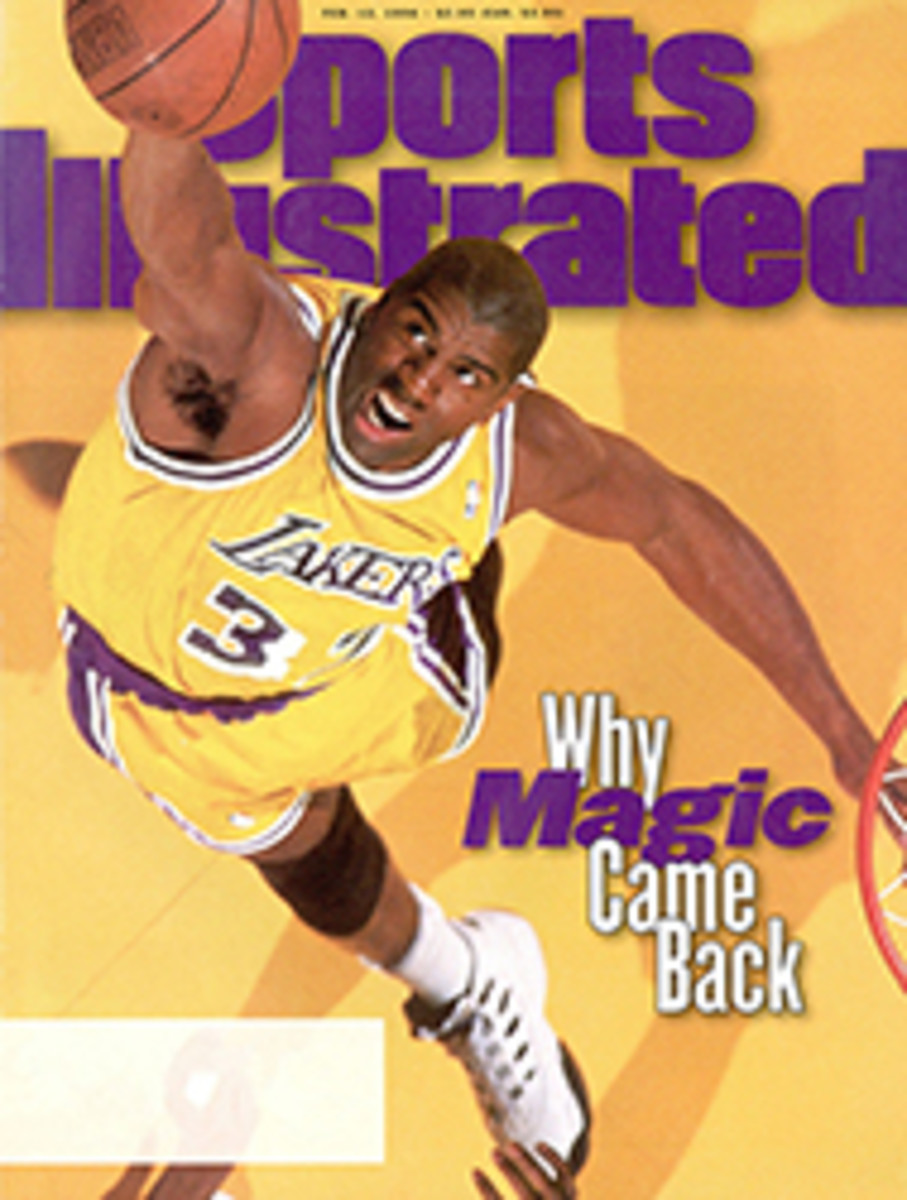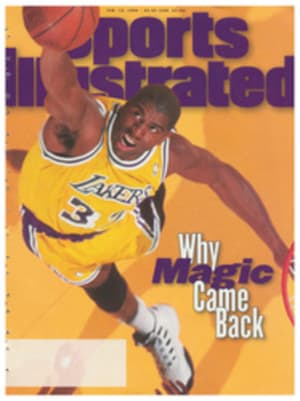
TITANIUM DRIVERS MADE OF THIS SPACE-AGE METAL MAY BE MORE ACCURATE AND LONGER. THEY'RE SURELY COSTLIER
You kept waiting for the ka-boom! Windows should have rattled
and saucers should have danced across tables, as happened in
1947 when Air Force Captain Chuck Yeager became the first pilot
to fly an aircraft through the sound barrier. This barrier,
however, was broken quietly, indoors and without warning, when
Ram Golf president Jim Hansberger--wearing a coat and tie instead
of the traditional fireproof jumpsuit--introduced the Ram FX
Ti-Forged oversize titanium driver. Suggested retail price:
$1,000.
No ka-boom! Just the crisp click of a few dozen b.s.-detector
needles pinned in the red zone. Yes, a couple of other companies
also had exotic drivers that cost more than a grand, but when
Ram, a mainstream manufacturer, upped the ante, hundreds of
backs snapped to attention and many eyes widened as the news
spread across the floor of Orlando's Orange County Convention
Center, which was not only the site of the recent PGA
Merchandise Show but also the venue of the great unveiling.
"What a mess," said a sales rep for a rival equipment company,
referring to the escalating price of clubs. "Kind of takes your
breath away," said another.
Welcome to the age of titanium. The wizards in R and D--that's
Rationalization and Dilemma, if you haven't been paying
attention--have turned in their findings, which are:
1) Titanium, a strong, light element heretofore used mainly as a
metal in aerospace and medical applications, appears to be the
best material yet for the manufacture of golf club heads.
2) Titanium costs too much.
Or it doesn't, depending on whom you talk to. For more than a
year Titleist and MacGregor have been selling oversize titanium
drivers for less than $300--or trying to, anyway. "They haven't
sold any," says Callaway Golf CEO Ely Callaway, smiling broadly.
"Ask any retailer." (We did. He's right.) Callaway, on the other
hand, has shipped 300,000 of its Great Big Bertha titanium
drivers, which retail for a robust $500. Industry giant Cobra,
seeking to establish itself in metal woods, has trumped Callaway
by pricing its King Cobra Ti (pronounced tee-eye) driver at a
mere $367, causing industry experts to conclude that Callaway
either will lower its price (it'll have to, if everybody follows
Cobra's lead) or thumb its nose at the competition (Callaway is
arrogant enough to keep the price up, no matter what others
charge). At Founders Club, whose Judge titanium driver sells for
$475, metal woods pioneer and company founder Gary Adams
concedes, "Those people who drive a Mercedes will want to own a
titanium driver."
The prices are no more bewildering than the contrasting
performance claims. Taylor Made's ads for the titanium version
of the Burner Bubble promise "20% more drives in the fairway"
but not added distance, and vice president of marketing George
Montgomery says, "On dead-center hits the ball doesn't go any
farther than it does off a stainless steel head." Over at
Mizuno, on the other hand, engineers have joined an oversize
titanium head to a daunting, 46-inch shaft and are pushing the
proposition that titanium adds yards. "We're in the distance
business," explains Mizuno club designer and PGA Tour player
Harry Taylor. "If you want accuracy, take a short shaft and pop
it down the fairway."
Ready to throw up your hands? Consider the Wilson Invex titanium
driver, which boasts an almost holographic finish. Says a Wilson
Sporting Goods sales rep, "It looks kind of like a salmon right
out of the river."
To traditionalists, the fish-out-of-water metaphor hits the
mark: What works in the airframe of the stealth bomber won't
automatically work on the first tee at Cypress Point.
Metallurgists who work with titanium say that it is an exotic
and temperamental substance. "It's a strange material," says
Mickey Pope, vice president of Selmet Inc., an Albany, Ore.,
titanium foundry. For one thing, while abundant, titanium is
difficult to extract and refine. Although noncorrosive and 40%
lighter than steel, titanium requires 16 times more energy to
produce. Furthermore, titanium has to be cast in a near vacuum
and requires a centrifugal, not a static, casting process. That
means you have to spin molds around at 400 rpm in an atmosphere
as thin as the moon's. For all these reasons, titanium club
heads wind up costing about 10 times as much as stainless steel
ones.
Why bother? Well, look at titanium's numbers: atomic weight,
47.90; melting point, 1,660 degrees C; density, 4.51 grams per
cubic centimeter. Put simply, a club head made of titanium can
be much larger than one that weighs the same but is made of
steel (for example, Callaway's titanium Great Big Bertha
measures 250 cc, which is 25% larger than the steel Big Bertha,
yet it is 10% lighter). In turn, bigger club heads are more
forgiving on off-center hits. Although a larger club head is
subject to more aerodynamic drag, the use of long, lightweight
shafts--45 inches (as opposed to 43 1/2 inches) is standard for
most titanium drivers--produces higher speed at impact. This
explains why equipment companies can choose to emphasize either
distance or control in their designs and advertising. If all
this is new to American golfers, it's because they can't read
Japanese. Mizuno and Rainbow were selling titanium drivers in
Japan six years ago, and today titanium metal woods claim 60% of
the Japanese market. "Titanium is not just window dressing,"
says Founders Club vice president Tom Garrity. "It's really
going to be the next era."
Others are not so sure. "Our position on titanium is that it is
a lot of smoke and mirrors," says Bob Verplank Jr. of Kunnan
Golf, maker of a composite graphite driver. Kunnan ads say,
"Titanium offers only a larger head for twice the cost." Snake
Eyes Golf Clubs CEO Ernie Vadersen, whose company makes
stainless wedges, thinks the whole oversize head trend is a
blind alley and titanium a sham. "We've tested titanium versus
stainless steel alloys, and we've found maybe a one-percent
difference--and not always for the good," Vadersen says. "The
marketing guys like it: big head, big price, big bucks."
The holdouts are led by Karsten Manufacturing, maker of Ping
clubs. "We're looking for distance in drivers," says Karsten
president John Solheim, apparently unimpressed by the average
carry of Boeing airliners. "And we're concerned that they're
trying to move golf clubs into a new price range. We were always
high-priced, but it's amazing how far things have gone."
This is when all heads turn toward Ely Callaway, who is blamed
for--or credited with--pricing titanium at platinum-card levels.
"There's really no reason why that club should cost $500," says
Bridgestone Sports' Gary Renelt. "The average titanium head
costs $100 to $125, and we all know the cost of shafts and
grips." More bluntly, another company's rep claims titanium is
pricey only "because the bastards at Callaway are charging too
much."
That's the sort of accusation that brings a gleam of pleasure to
Callaway's eyes. "We charge what we think our product is worth,"
he said at the PGA show. "We think ours is worth $500."
Fair enough. Ram's Hansberger thinks his is worth $1,000. After
all, Hansberger's club is hand-forged, not cast; it's made of
"pure" titanium (99%, actually), not the alloy (90% ti, 6%
aluminum and 4% vanadium) favored for centrifugal casting; and
it comes with a calfskin grip and a suede head cover. "Frankly,"
Hansberger told reporters in Orlando, "it's worth every penny."
But if you don't think so, Hansberger will gladly sell you Ram's
low-end, oversize titanium driver, the Big Eye TI--the club with,
say the ads, "the accuracy of a Seeing Eye dog." Suggested
retail price: $199.
Thud.
Things that fall, need we be reminded, also make a pretty loud
noise.
COLOR PHOTO: BEN VAN HOOK [Golf clubs arranged so that their heads form letter "T"]
TWO COLOR PHOTOS: JACQUELINE DUVOISIN (2) The top earners of '95 (Jim Colbert, Annika Sorenstam, Greg Norman) have all bought into ti. [Jim Colbert; Greg Norman]
COLOR PHOTO: ROBERT BECK [See caption above--Annika Sorenstam]
COLOR PHOTO: ROBERT BECK [Mark Calcavecchia]
WAY HIGH TI...
We understand. If pros like Mark Calcavecchia (right) pack ti,
you've got to have some too. Here are suggested prices, as
compiled by Andy Brumer, of titanium clubs on the market.
(Remember, Calc didn't pay for his.)
DRIVERS*
Maruman Titus Titan $1,200
PRGR SD 1,050
Ram FX Ti-Forged 1,000
Mizuno T-Zoid 650
Echelon B2B 599
Callaway Great Big Bertha 500
Cleveland VAS 500
Confidence Golf 260 Ti 500
Dynacraft Super Ti 500
Nicklaus Air Bear 500
Gary Player Black Knight 499
Founders Club Judge 475
HOGAN Edge GCD 460
Rainbow Sealed Power 450
Rawlings FT-190 450
Yonex Super ADX 450
Lynx Black Cat 435
Adams Air Assault 420
Daiwa Exceler 415
Taylor Made Titanium Bubble 400
Kunnan EXT 395
Titleist SS Howitzer 375
Tommy Armour 855 Tommy Gun 375
Cobra King Cobra Ti 367
Pro Group PHD 360
Magique Gold Cactus 350
ryobi-Toski Czar 350
Cubic Balance Mega-Size Grooveless 330
Bridgestone Precept 299
Wilson Invex 299
MacGregor VIP 285
Spalding TF Intimidator 285
Mitsushiba MTS 259
Golfsmith Ti-250 250
Tiger Shark Ti Shark 250
Bullet Invincible Jumbo 225
Pro Select Prism 199
Powerbilt T-Minus 125
IRONS (Set of 8)*
Daiwa G-3 Titan $3,200
Maruman Titus WA-2 3,000
Ray Cook Titanic 1,672
Mizuno TI 22 1,665
Yonex Super ADX 1,600
ryobi-Toski Czar 1,500
Maruman M301 T 1,350
Rainbow Sealed Power Ti 1,200
Estusa Maverick 1,040
Rainbow Boomer Ti 960
Golfsmith Extreme Impact 840
* With graphite shafts.
...BUYER'S GUIDE
1 Look beyond the word titanium. The titanium revolution is about
oversize heads, not titanium-threaded grips or bag tags. Some
companies offer low-priced "titanium" drivers but use ti only in
the hosel or in face inserts. If these clubs perform well--and
there's no reason why they shouldn't--it's not because of their
tiny titanium content.
2 Don't let titanium's gleam blind you to a club's design. "The
magic isn't in the metals," says Ram's Jim Hansberger, "it's in
the engineering." In other words, a well-designed stainless
steel club is better than a poorly engineered titanium club.
3 Go for the bigger club heads. Unless you're a low handicapper
who can work the ball, you have little to gain by dropping a
bundle on a mid-size ti with a shaft that is shorter than 45
inches. Ask for a head in the 240-260 cc range.
4 Take a test drive. You'll probably like the feel and forgiveness
of titanium, but before you spend hundreds, face the fact that
ti won't cure your slice. As Ping's John Solheim says, "The
biggest technical innovation is to get a better golf swing."
--J.G.

